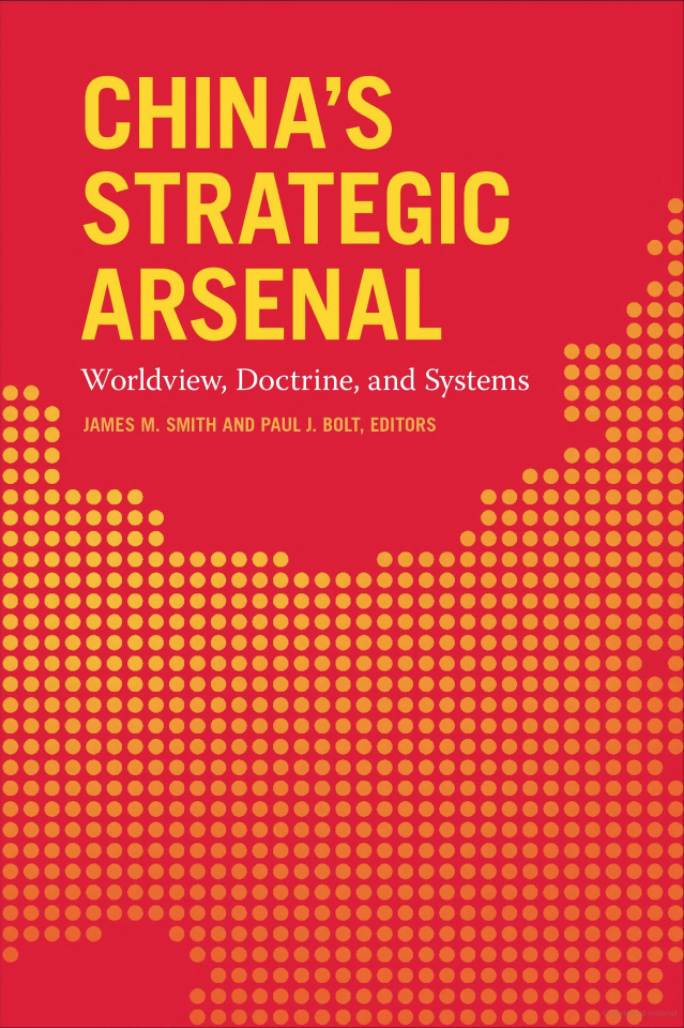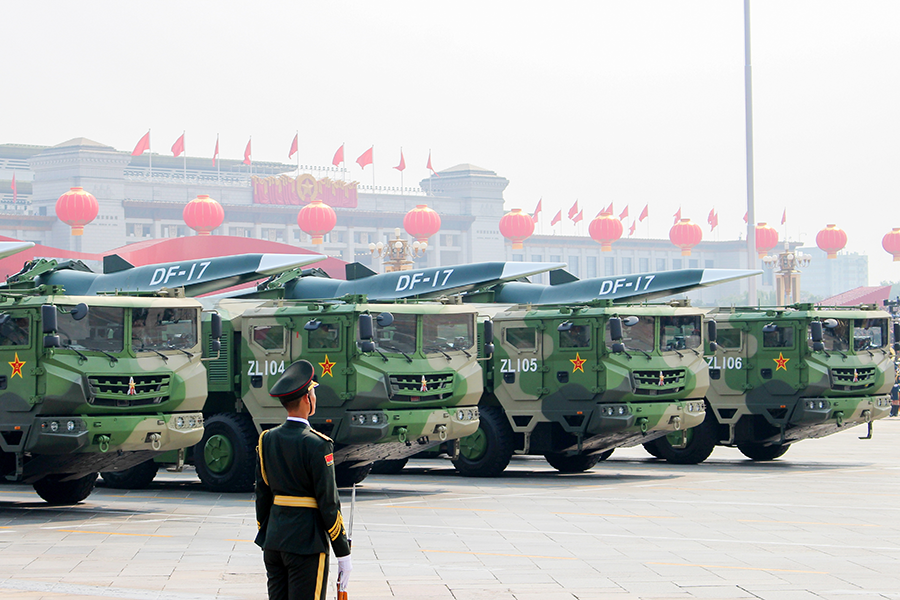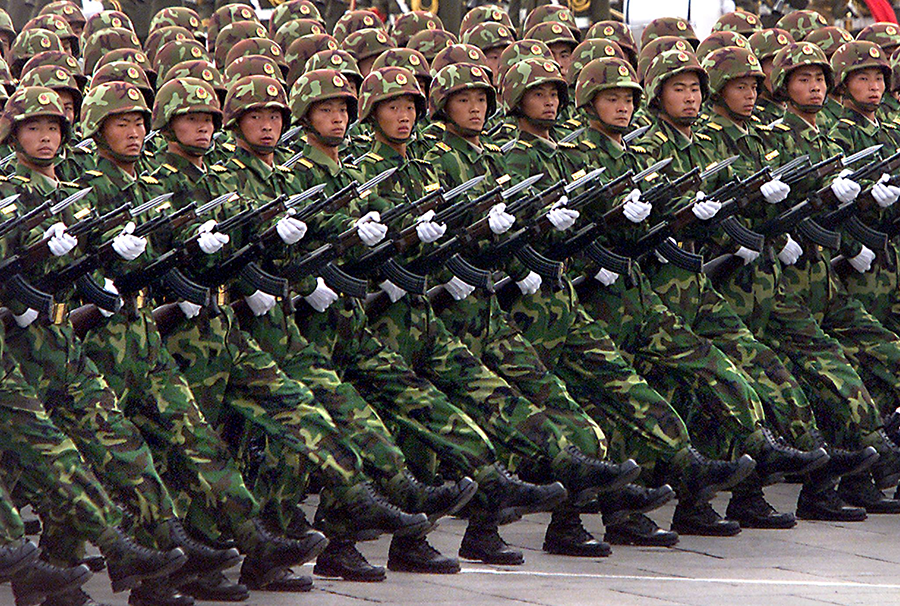"I greatly appreciate your very swift response, and your organization's work in general. It's a terrific source of authoritative information."
China’s Strategic Arsenal: Worldview, Doctrine, and Systems
December 2021
Digging Deep Into China’s Motivations and Intentions
China’s Strategic Arsenal: Worldview, Doctrine, and Systems
James M. Smith and Paul J. Bolt, Editors
(Georgetown University Press, 2021)
280 pages
Reviewed by Tong Zhao
Many op-eds have been written this year as more revelations emerged about the surprising speed and scale of China’s nuclear expansion. The reported construction of more than 200 new missile silos and the testing of an orbital hypersonic glider drew most of the international attention, but there may be more than meets the eye. Given that Chinese President Xi Jinping instructed the People’s Liberation Army in March to “accelerate the construction of high-level strategic deterrent” systems, more details about China’s comprehensive efforts to rapidly develop its nuclear triad capabilities will likely emerge.
These developments are taking place at a critical juncture, when the Biden administration is deliberating the future of the U.S. nuclear posture and China’s national power continues to grow even though the country’s overall strategic orientation has become increasingly unclear. In light of the growing ambiguities and all the moving pieces, only a holistic and systematic examination of China’s nuclear strategy could hope to offer deep and accurate insight about what is going on and the implications. The book, China’s Strategic Arsenal: Worldview, Doctrine, and Systems, edited by James M. Smith and Paul J. Bolt with contributions from a stellar group of leading experts, does exactly that. Admittedly, the book does not include the most recent Chinese capability developments, especially in 2021. That would be an impossible task given the fast developments in the program. Yet, the book performs an excellent service by enriching the public debate with a deep, nuanced review of the key technical, doctrinal, geopolitical, and cultural dimensions of the evolving nuclear thinking that appears to be shaping China’s current and future policy.
Reasons for the Buildup
Such a holistic approach helps avoid attributing China’s nuclear buildup to any singular cause. For instance, even though the perceived threat from U.S. missile defenses may still be the most important technical factor affecting the calculations of Chinese nuclear strategists, the incremental development of these U.S. capabilities cannot satisfactorily explain the relatively abrupt acceleration of China’s nuclear buildup. The reported construction of hundreds of missile silos across at least three suspected silo sites—a deployment strategy not optimal for countering missile defense—also indicates a growing Chinese concern about a possible U.S. preemptive nuclear strike. Why does China believe there is a such a threat? Why is China experimenting with exotic nuclear delivery systems that other countries perceive as excessive for dealing with realistic threats in the foreseeable future? Many analysts stop short of asking these deeper and potentially more important questions, but this book makes a particular effort to address them.
 The book includes a timely and helpful analysis of the impact of China’s contemporary worldview, which increasingly may be shaping its perception of and approach to nuclear weapons more than any technical factors. Contributing author Andrew Scobell observes that China’s major “defense projects are the logical manifestations of a highly determined Leninist regime possessing ‘an extreme sense of insecurity.’” This insecurity appears to have become even more extreme in recent years as efforts by China’s paramount leader to centralize domestic power and strengthen internal control were met with growing criticism from the United States and other Western countries over issues such as human rights, democratic governance, and the rule of law. The West’s efforts to defend these long-held principles and values thus present the gravest threat to China’s security, as a result of “national security being conflated with regime security” by Beijing. As the Chinese leadership becomes increasingly alarmed by the growing threat from the U.S. “ideological confrontation” with China’s “political security” and “regime security,”1 a stronger nuclear capability could force the United States to acknowledge mutual vulnerability and accept peaceful coexistence with China under its current political system.
The book includes a timely and helpful analysis of the impact of China’s contemporary worldview, which increasingly may be shaping its perception of and approach to nuclear weapons more than any technical factors. Contributing author Andrew Scobell observes that China’s major “defense projects are the logical manifestations of a highly determined Leninist regime possessing ‘an extreme sense of insecurity.’” This insecurity appears to have become even more extreme in recent years as efforts by China’s paramount leader to centralize domestic power and strengthen internal control were met with growing criticism from the United States and other Western countries over issues such as human rights, democratic governance, and the rule of law. The West’s efforts to defend these long-held principles and values thus present the gravest threat to China’s security, as a result of “national security being conflated with regime security” by Beijing. As the Chinese leadership becomes increasingly alarmed by the growing threat from the U.S. “ideological confrontation” with China’s “political security” and “regime security,”1 a stronger nuclear capability could force the United States to acknowledge mutual vulnerability and accept peaceful coexistence with China under its current political system.
Influential Chinese public opinion leaders such as Hu Xijin argue that to contain such U.S. “strategic ambition and restlessness” against China, Beijing has to build an arsenal greater than its traditional second-strike capability.2 Such views seem to resonate with a Chinese population that is increasingly nationalistic and likely also aligns with Xi,who sees the United States as “the biggest source of chaos in the present-day world” and instructs all party officials to adopt the “fighting spirit” against such threats.3 If Chinese leaders think nuclear weapons can and should play a greater role in countering perceived U.S. political aggression, it would significantly change China’s traditional approach to nuclear self-restraint. For instance, if the nuclear buildup does not lead to the expected result of making Western powers treat China with respect—by ending human rights-related pressure on China, for example—even more nuclear buildup might be viewed as necessary.
Beijing’s growing determination to achieve its perceived territorial interests may also account for the nuclear buildup. Some Chinese experts believe the expansion is directly driven by a growing determination to achieve national unification with Taiwan in the foreseeable future. If it comes to the point where that is only possible by military means, a stronger Chinese nuclear force could reduce the ability of the United States to use the threat of nuclear escalation to interfere in China’s conventional military operations across the Taiwan Strait. As long as Beijing can effectively contain the nuclear escalation threat from Washington, China’s growing conventional military advantages in the region give it confidence that it would be able to deter and defeat any conventional military interventions.
Contributing author Sugio Takahashi points out another potential driver of China’s nuclear buildup: its interest in acquiring the capability to manage escalations. A secure second-strike capability coupled with a massive retaliation policy could help China deter a large-scale nuclear attack, but may not credibly deter a small-scale, limited nuclear attack and could be viewed as insufficient for conducting nuclear escalation management operations. As early as the 1980s, Chinese nuclear strategists started thinking about scenarios other than an all-out nuclear exchange.4 It is possible that China has been interested in pursuing a more sophisticated nuclear capability and posture that allows it to conduct a symmetric or proportionate nuclear response on various rungs of the escalation ladder. Indeed, a more diversified and increasingly more accurate nuclear arsenal would allow China to hold at risk not only big cities and other types of soft targets but also a wide array of military targets at various ranges. This gives China the option of conducting limited, reciprocal nuclear countermilitary strikes at the regional or strategic level to achieve escalation management. Admittedly, such capabilities could also enable China to initiate a limited nuclear strike during a conventional conflict, although China’s growing confidence in its conventional capabilities would reduce the Chinese incentive to do so.
The ideological confrontation appears to have persuaded Chinese leaders that the United States is increasingly willing to take greater risks to destabilize China. This may have intensified Beijing’s concern about possible nuclear escalation by the United States if a future conventional conflict, such as one over the Taiwan Strait, starts to get out of control. U.S. efforts to introduce low-yield nuclear weapons into its arsenal, although primarily aimed at addressing the perceived threat of Russia using tactical nuclear weapons in conventional wars, have been interpreted by Chinese experts as Washington’s attempts to develop nuclear war-fighting capabilities that lower the threshold of nuclear use. As China’s concerns about U.S. nuclear coercion rise, its sense of urgency to acquire effective escalation-management capabilities probably grows too.
China’s more explicit pursuit of escalation-management capabilities would have important implications. Nuclear restraint is more difficult when a nuclear power’s goal is to manage escalation in addition to securing a credible second-strike capability. When two nuclear rivals compete over escalation management, their competition is likely to become more zero-sum in nature because one’s capacity to manage escalation would likely be viewed as threatening the other’s capacity to do so. This dynamic contributed to the insane nuclear arms race between Washington and Moscow during the Cold War and today could lead to greater risks of a U.S.-Chinese nuclear arms race.
At the operational level, the pursuit of an escalation management capacity could drive new technological development. China’s recent investment in theater-range nuclear forces could enhance its escalation management capacity at the regional level. Under a circumstance in which a potential nuclear conflict rises along the escalation ladder and involves a limited U.S. nuclear attack on selected military targets on Chinese territory, Beijing might need the capacity to effectively deliver a limited nuclear retaliation against selected military targets on the U.S. homeland too. China might not have viewed such extreme scenarios as sufficiently realistic previously, but its heightened strategic threat perception in recent years could motivate more serious planning against these circumstances. That could be especially true when Xi repeatedly admonishes Chinese officials to adopt so-called bottom-line thinking, which warns against underestimating the hostility of an enemy and stresses the importance of preparing for the worst possible scenarios.
 Delivering a limited nuclear strike against the U.S. homeland could impose a more demanding requirement on China’s capabilities than delivering a nuclear retaliation in an all-out exchange. Current U.S. homeland missile defenses cannot pose a realistic threat to China’s second-strike capability, but they could become a considerably greater threat to a limited Chinese nuclear strike. It is difficult to tell at this point whether China’s reported development of exotic nuclear delivery technologies, such as the reported test of an orbital hypersonic-glider system, is driven by an interest to acquire a limited nuclear strike capability against the U.S. homeland for the purpose of achieving escalation management. If escalation management indeed becomes China’s goal, however, traditional understandings about the U.S.-Chinese nuclear relationship and strategic stability would need to be fundamentally reexamined.
Delivering a limited nuclear strike against the U.S. homeland could impose a more demanding requirement on China’s capabilities than delivering a nuclear retaliation in an all-out exchange. Current U.S. homeland missile defenses cannot pose a realistic threat to China’s second-strike capability, but they could become a considerably greater threat to a limited Chinese nuclear strike. It is difficult to tell at this point whether China’s reported development of exotic nuclear delivery technologies, such as the reported test of an orbital hypersonic-glider system, is driven by an interest to acquire a limited nuclear strike capability against the U.S. homeland for the purpose of achieving escalation management. If escalation management indeed becomes China’s goal, however, traditional understandings about the U.S.-Chinese nuclear relationship and strategic stability would need to be fundamentally reexamined.
The New Political Reality
Contributing author Nancy Gallagher highlights the need to redouble efforts to engage China on arms control to contain the risk of a nuclear arms race and nuclear use. Yet, the U.S. debate on this issue remains limited. Many U.S. experts focus on the importance of technical-level factors such as missile defense and seem to believe that U.S. efforts to limit its missile defense capabilities by itself would effectively remove China’s incentive to build up its nuclear capabilities. This view may overestimate the importance of technical-level factors.
The much-heightened Chinese threat perception appears less driven by the incremental development of any one U.S. weapons systems than political factors such as the recent drastic shift in China’s domestic and international orientations and the subsequent ideological confrontation between Washington and Beijing. Whether China’s nuclear buildup is intended to further assure its second-strike capability and strengthen regime security and international political leverage, to prevent nuclear escalation in a conventional military maneuver to achieve unification with Taiwan, or to acquire an escalation management capacity, political and strategic considerations seem to influence China’s thinking more than technical factors.
As China undergoes significant domestic changes, international nuclear policy experts can benefit from developing a deeper understanding of the domestic environment in which China’s nuclear policy changes are taking place. Contributing author Brad Roberts wonders if “the sense of insecurity that grips China’s leaders is deeply engrained in” and “reinforced by the inherent [nature of the political system]…and cannot be washed away by increased military strength.” He writes that:
The consequences of China’s strategic military modernization are intimately connected with the fate of political reform in China. The apparent failure to liberalize as it modernizes has sharply lowered the expectations of those Chinese who had hoped that embracing economic reform would generate political change of a kind valued by democratic states. But China’s leaders have gone beyond a mere rejection of liberalization. Rather, they have framed the competition with the United States as significantly ideological in character, with the aspiration to provide a competing model for the correct ordering of political life and to see that model flourish elsewhere.
China policy specialists point out that another dimension of the domestic change is that the unprecedented concentration of decision-making power under one person would further remove any remaining internal checks and balances within the system. Tightened security rules in recent years work to ensure only a very small number of insiders know what capabilities China is developing and why. As the Chinese state media dismisses foreign reports of China’s nuclear expansion, the majority of Chinese nuclear policy experts have even less capacity to understand what is going on than their foreign counterparts who have access to satellite imagery and other open-source tools. At the unclassified level, there is very little expert discussion, let alone debate, in China about how much nuclear capability would be sufficient to achieve what security objective, and almost no question is raised about the rationale and wisdom of China’s current nuclear development and its future trajectory. As the system is increasingly reorganized to ensure efficient and unquestioning implementation of Xi’s vision, his apparent interest in acquiring a stronger nuclear force fuels a positive feedback process in which experts and officials find their own interests best served by promoting the leader’s vision. The system is ridding itself of the capacity to conduct self-reflection and course correction from within.
Ironically, in some cases, Western experts may be unconsciously contributing to the groupthink in China. Many U.S. experts are deeply frustrated with the polarizing partisanship and other seemingly insoluble problems in the U.S. political system. They do an invaluable service for the international community by scrutinizing U.S. foreign and security policy and holding the government accountable so that the No. 1 superpower does not make terrible policy choices and throw its own people and the rest of the world in harm’s way. This inclination for critical self-reflection and empathy toward one’s rivals is not only applaudable but imperative to resolve international disagreements and develop international trust. China, however, appears to increasingly dismiss the usefulness of alternative perspectives and reject the idea of internal checks and balances, working on the assumption that China is an inherently pacifist, responsible country and that any hope to stabilize the U.S.-Chinese relationship rests with Washington correcting its wrongful behaviors. As it happens, negative U.S. expert commentary about U.S. policy and sympathetic commentary about Chinese policy are widely promulgated in China and help reinforce the country’s self-perception.
This does not mean that Western experts should stop holding their own governments accountable, but there is a need for more nuanced understandings about how internal and external factors may work together to shape the strategic perspective of an increasingly centralized political system. If people really believe in the theorem that checks and balances are imperative for accountability, they should pay attention to any place where such checks and balances may be lacking. Especially in the nuclear field, any country’s bad choice can cause tremendous harm to all. As Xi likes to say, we live in an interconnected world.
In this spirit, I believe this book will help readers develop a comprehensive and nuanced understanding of China’s nuclear policy, along with its evolving strategic perspective, at a time when an informed and in-depth international debate is badly needed in order to promote clear and constructive thinking about the future.
ENDNOTES
1. Dazhi Yang, “政治安全是国家安全的根本” [Political security is the root of national security], PLA Daily, April 20, 2018, http://www.mod.gov.cn/jmsd/2018-04/20/content_4809950.htm.
2. Xijin Hu, “胡锡进看到了什么,强烈主张中国扩大核力量” [What Hu Xijin sees that made him strongly advocates[sic?] China’s expansion of nuclear forces], Global Times, May 9, 2020.
3. Chris Buckley, “‘The East Is Rising’: Xi Maps Out China’s Post-Covid Ascent,” The New York Times, March 3, 2021; “习近平激励年轻干部发扬斗争精神” [Xi Jinping inspires young cadres to carry forward the fighting spirit], Xinhua News Agency, September 9, 2021, http://www.news.cn/politics/leaders/2021-09/09/c_1127842766.htm.
4. Alastair Iain Johnston, “China’s New ‘Old Thinking’: The Concept of Limited Deterrence,” International Security, Vol. 20, No. 3 (Winter 1995-1996): 5-42.
